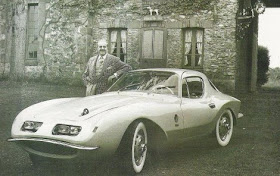As outlined in yesterday's post, a crack team of industrial designers managed to get a new car from clay model to drivable test cars for the NYC Auto Show in a year. This effort is even more remarkable when considering the coordination required to acquire tooling, fabricate molds for fiberglass bodies, and line up suppliers for the myriad components that go into a car. What Studebaker had as a starting point was a sturdy and reliable V8 which could form the basis of a performance car. And what Raymond Loewy had was a collection of notions about where car design might be headed, notions he had explored in two previous concept cars which he'd also used as daily drivers to evaluate ideas. Some of these ideas appeared in the first sketches produced by the sequestered Palm Springs design team in 1961. The first obvious source of ideas was a special BMW 507 coupe bodied to Loewy's design by tiny French coach builder Pichon et Parat in 1957.
Cars did not look like this in 1957. Among the ideas which appeared 5 years later on the Avanti are the bumper which surmounts a simple, curved air intake and the asymmetrical raised portion of the hood which houses the logo (in the case the blue and white BMW roundel). The oblong headlight units were prototypes made available by Sylvania and were not approved for use on US highways; on the 1964 version of the Avanti (roughly the last 800 cars built) and on the later Avanti II a similar effect was achieved by placing an oblong frame with glass covers over conventional round headlight units. Here the arc of the fenders over the front wheels flows down and over the bumper / grille assembly, providing continuity of form. This car might have been a bit happier with concealed headlights, especially as these units were illegal anyway...
In both views of this car, it's easy to see the genesis of the horizontal crease linking the front and rear wheelhouses. On this BMW, however, it arcs over the rear wheels and wraps around the tail, linking the curved wheel arches to the echoing wrap of the rear window. As on the Avanti, the body wraps tightly around the wheels, and the wheel openings are not concentric with the wheels. But here the thrust of the openings is forward rather than rearward. Two features clearly visible here did not make it onto the Avanti. One is the pronounced wrap of the door openings into the roof, designed to ease entry into the low cockpit. The wrap-over doors did appear, however, on the Corvette Sting Ray coupe for 1963. The other is the sharp ridge formed at the junction of the upper and lower rear fender surfaces. Richard Teague employed this sine wave / ridge combo on the early 70s AMX3 show cars for American Motors. In its uninhibited curvilinear exuberance, Loewy's futurist design also looks backward, to the teardrop coupes designed for Talbot Lago chassis by Joseph Figoni in the late 1930s. Raymond Loewy was very much aware of those cars…
In 1959 Loewy commissioned Motto of Turin to build his design for an aerodynamic coupe on a Lancia Flaminia chassis. At least in its rear three-quarter view, it provided more links to the themes that were used in the Avanti. Note the clean, tapered tail with short overhangs, blade-like bumper, horizontal tail lights and generously curved window. The boundary layer airfoil above that window was an advanced feature, and only appeared on production cars much later. In this view, the Lancia Loraymo is a more restrained design than the BMW.
Loewy, who never hesitated to experiment with new ideas, was equally ready to discard ineffective ones, and somehow never let go of a good idea. It was this persistence in pursuit of lightness, safety and efficiency which was echoed in the title of his book, "Never Leave Well Enough Alone", and which led to consulting work for NASA as well as work on Air Force One. It also seems to have infused the thinking behind Studebaker's last new production design, one which outlasted the company by a quarter century.
Photo credits:
BMW coupe and Lancia Loraymo: Raymond Loewy Associates
1938 Talbot Lago teardrop coupe: Stylepinner.com
Studebaker Avanti: Studebaker Corporation






No comments:
Post a Comment